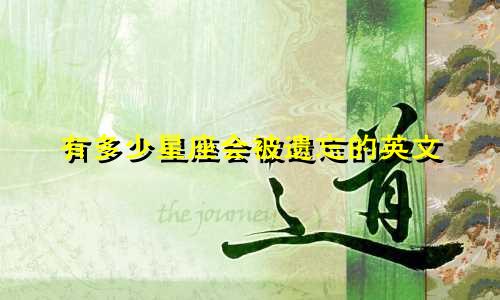有多少星座会被遗忘的英文
The concept of zodiac signs, deeply rooted in astrology and astronomy, has been an integral part of various cultures for centuries. These signs, based on the positions of celestial bodies at the time of one's birth, are believed to influence personality traits, behaviors, and even future events. However, as we delve into the vast expanse of history and mythology, it becomes evident that not all zodiac signs have stood the test of time. Some have faded into obscurity, forgotten by modern society but still holding significance in ancient texts and traditions.

The Lost Zodiac Signs:
1. Ophiuchus (The Serpent-Bearer): This constellation, representing Asclepius, the Greek god of medicine, lies between Scorpio and Sagittarius. Despite its recognition as the thirteenth astrological sign by astronomers, Ophiuchus is rarely included in traditional Western astrology due to its late addition and the dominance of the twelve-sign system established by the Babylonians.
2. Cancer Minor (The Little Crab): A smaller constellation near Cancer, it was once considered a separate zodiac sign in some ancient systems. Over time, it merged with Cancer, becoming less distinct and eventually forgotten.
3. Lynx (The Lynx): Representing a wild cat, this constellation was recognized in ancient Arabian astronomy but lost prominence as the zodiac evolved. Its absence from the modern zodiac highlights how cultural shifts can lead to the omission of certain signs.
4. Piscis Austrinus (The Southern Fish): Part of the larger Pisces constellation, it was historically seen as a separate entity. As astronomical understanding progressed, it was absorbed into Pisces, reflecting changes in how we perceive and categorize the night sky.
5. Ara (The Altar): Associated with sacrifice and religious rituals, Ara was once considered a significant constellation. However, its symbolic meaning shifted over time, leading to its exclusion from the mainstream zodiac.
6. Camelopardalis (The Giraffe): Representing a creature from mythology, this constellation was recognized in ancient times but gradually lost relevance as the zodiac system became more standardized.
7. Leo Minor (The Little Lion): Though not a full zodiac sign, Leo Minor's existence demonstrates how smaller constellations could be associated with larger ones, sometimes leading to their neglect or reclassification.
8. Ursa Major (The Great Bear): While not technically a zodiac sign, Ursa Major's prominent position in the sky made it a point of reference for early astronomers. Its enduring presence contrasts with those signs that have been lost to time.
9. Draco (The Dragon): Another non-zodiac constellation, Draco's inclusion here underscores the fluidity of celestial classifications throughout history.
10. Pegasus (The Winged Horse): Likewise, Pegasus serves as a reminder of the imaginative names given to constellations, many of which did not make it into the final zodiac lineup.
Why Are They Forgotten?
Several factors contribute to the forgetting of these zodiac signs:
- Cultural Evolution: As societies developed and interacted, their cosmologies and mythologies merged or diverged, leading to the adoption of different zodiac systems.
- Scientific Advancements: The rise of astronomy as a scientific discipline led to a more precise understanding of the heavens, often at the expense of older, more symbolic interpretations.
- Standardization: The need for a universal system facilitated communication and record-keeping, resulting in the consolidation of twelve primary signs.
- Geographical Differences: Different regions had unique perspectives on the night sky, influencing which constellations were deemed important.
- Historical Records: Many ancient texts detailing these forgotten signs have been lost or damaged over millennia, making it challenging to fully understand their significance.
In conclusion, while the twelve zodiac signs commonly used today hold a prominent place in popular culture and astrology, they represent just a fraction of the celestial stories told by humanity. The forgotten signs serve as a testament to our ever-evolving understanding of the universe and the rich tapestry of myths and legends that continue to inspire wonder and curiosity.
上一篇:十二星座的包容程度是多少
下一篇:返回列表






